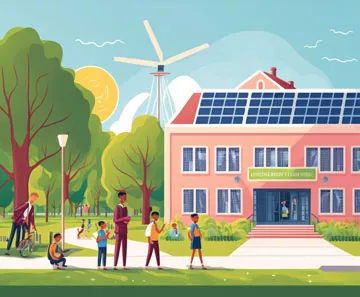| March 2023 |

By Ryan Hidden, Sierra Club Beyond Coal
K-12 schools need all-electric, high-performance HVAC systems that deliver health and learning benefits to students and supply broader climate and economic benefits for decades to come. The latest report from RMI, "HVAC Choices for Student Health and Learning: What Policymakers, School Leaders, and Advocates Need to Know," delves into the importance of transitioning to all-electric, high-performance systems for the health and learning of students, as well as for broader climate and economic benefits. This report is intended to support informed decision-making by school district leaders, policymakers, and advocates at the local, state, and federal levels.
With 41% of school districts needing to update or replace their HVAC systems, now is the time to make the switch. The report’s original analysis shows that the current school HVAC systems result in carbon emissions imposing an estimated $2 billion (about $6 per person in the US) in societal costs yearly. To reduce this cost, schools must shift away from outdated, inefficient HVAC systems reliant on polluting fossil fuels in favor of efficient, electric systems.
These modern systems serve schools and their students by meeting growing cooling needs, reducing carbon emissions and societal costs, improving air quality, reducing school operational costs, among other benefits. Stark inequities in the condition of school facilities from chronic underinvestment in low-income communities and communities of color make it even more urgent that these schools can access these technologies.
The report includes research connecting HVAC systems to student health and learning, six big ideas about HVAC technology, and an original analysis profiling HVAC systems nationwide. It also highlights the six benefits of all-electric, high-performance systems and supplies a framework for evaluating costs and funding options.
Six big ideas about school HVAC technology:
- Advances in technology allow us to move heat rather than make heat (even in cold climates)
- Schools that use high-performance filters are better positioned to remove contaminants
- Schools in every climate can select cost-effective ventilation strategies
- All HVAC systems require ongoing monitoring and adjustment
- Good HVAC system decisions are sensitive to context
- HVAC systems account for the majority of school energy use, utility costs, and greenhouse gas emissions
Six benefits of selecting all-electric, high-performance HVAC systems:
- Adapts to new cooling needs
- Improves air quality and eliminates combustion pollution
- Enhances efficiency
- Minimizes health and safety concerns
- Builds energy resilience
- Mitigates climate change
With new funding opportunities, such as the Inflation Reduction Act of 2022, school district leaders can make HVAC investments that genuinely support their students and communities. Take advantage of this opportunity to improve your students' health and learning outcomes. Download the report now.
Ameren plans to roll out its carbon assessment program in 2023 and any schools in their territory can reach out to Michael Pittman, Ameren Public School Carbon-Free Assessments Program Manager, to schedule a free energy audit for your school. Contact Michael on 618.363.4438 (O), 618.363.4438 (M), or mpittman@ameren.com.